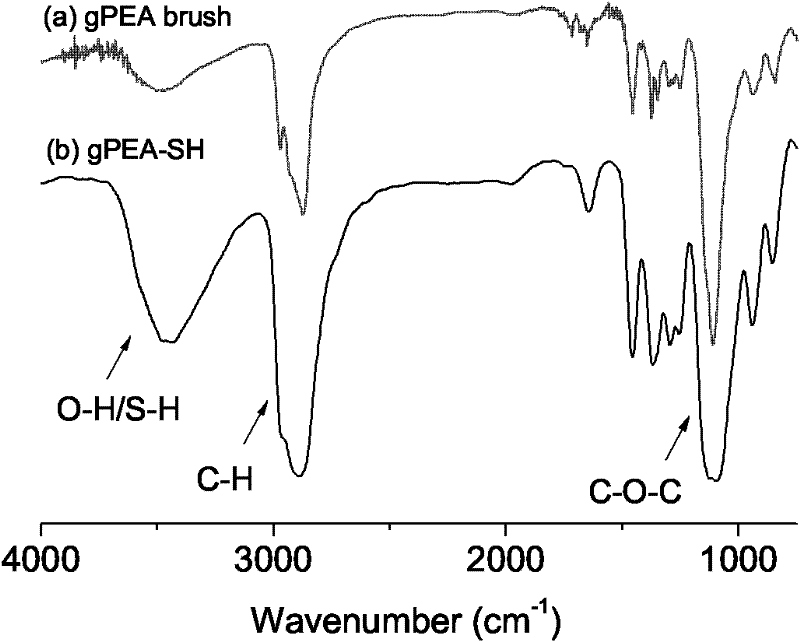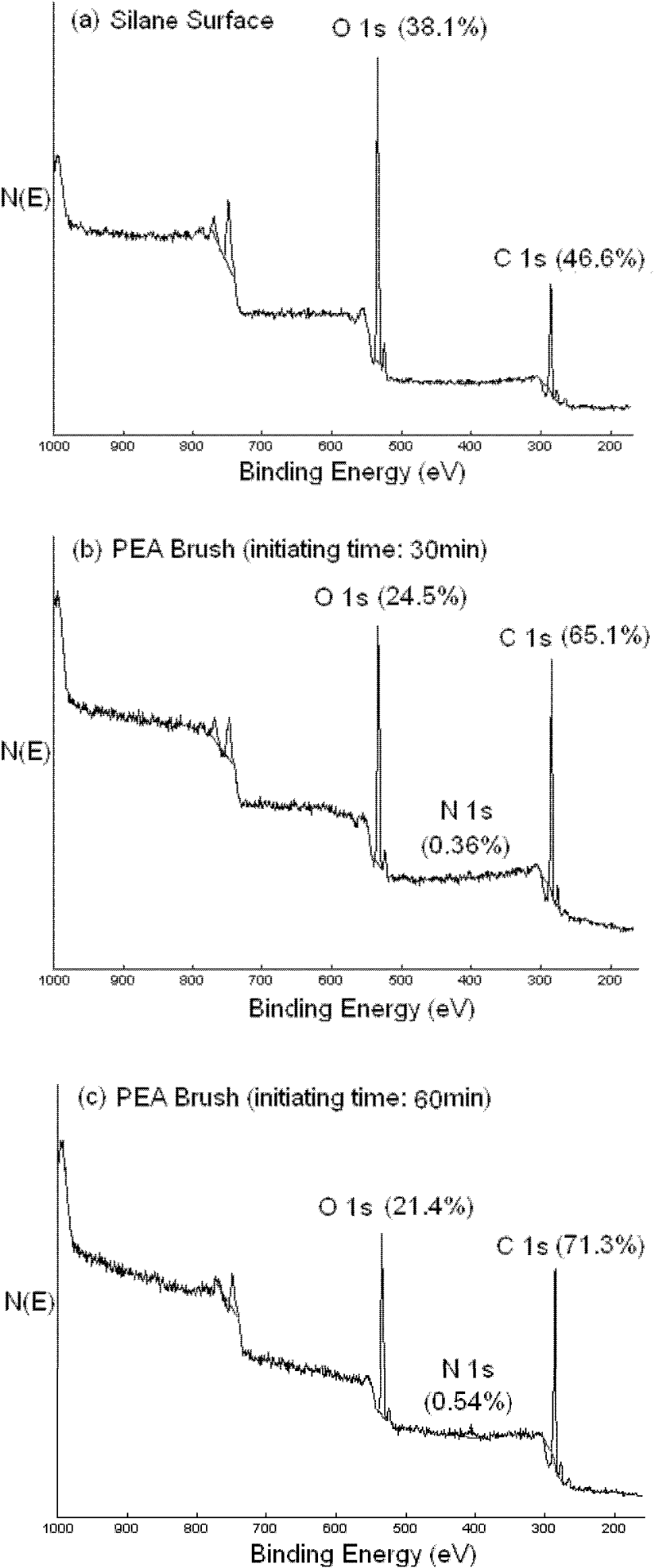Sulfur-alkene click chemistry-based method for preparing stimulation responsive polyether amine macromolecular brush
A stimuli-responsive, click chemistry technology, applied in the field of polymer chemistry, can solve the problems of difficult to obtain polymer films and low graft density, and achieve the effects of small environmental conditions, simple operation, and broad application prospects
- Summary
- Abstract
- Description
- Claims
- Application Information
AI Technical Summary
Problems solved by technology
Method used
Image
Examples
Embodiment 1
[0021] Such as figure 1 As shown, this embodiment includes the following steps:
[0022] 1. Synthesis of gPEA-SH
[0023] 1.28g (2mmol) PPO, 1.0g (1mmol) Jeffamine L100 and 0.077g (1mmol) mercaptoethylamine were added to 10ml of absolute ethanol, and the solution was reacted at 80°C for 24h under the protection of nitrogen. After cooling to room temperature, the solution was Pour into 10 times the volume of anhydrous ether, filter, and vacuum dry to obtain 2.2 g (93%) of gPEA-SH.
[0024] 2. Substrate treatment
[0025] Boil the silicon wafer substrate in a mixed solution containing concentrated sulfuric acid and hydrogen peroxide for 1 hour. The mass ratio of concentrated sulfuric acid and hydrogen peroxide in the mixed solution is 7:3. Rinse and dry to remove organic matter and impurities on the surface of the substrate.
[0026] 3. Self-assembly with alkenyl silane coupling agent
[0027] The cleaned and dried substrate was immersed in a 2 mM toluene solution of 3-meth...
Embodiment 2
[0037] 1. Synthesis of gPEA-SH
[0038] Add 1.28g (2mmol) of PPO, 1.0g (1mmol) of Jeffamine L100 and 0.077g (1mmol) of mercaptoethylamine into 10ml of absolute ethanol, and react the solution at 80°C for 24h under the protection of nitrogen. After cooling to room temperature, the The solution was poured into 10 times the volume of anhydrous ether, filtered, and dried in vacuum to obtain 2.2 g (93%) of gPEA-SH.
[0039] 2. Substrate treatment
[0040] Boil the silicon wafer substrate in a mixed solution containing concentrated sulfuric acid and hydrogen peroxide for 1 hour. The mass ratio of concentrated sulfuric acid and hydrogen peroxide in the mixed solution is 7:3. Rinse and dry to remove organic matter and impurities on the surface of the substrate.
[0041] 3. Self-assembly with alkenyl silane coupling agent
[0042] The cleaned and dried substrate was immersed in a 5 mM toluene solution of 3-methacryloylpropoxytrimethoxysilane and allowed to stand for 5 h. Then, the ...
Embodiment 3
[0048] 1. Synthesis of gPEA-SH
[0049] Add 1.28g (2mmol) of PPO, 1.0g (1mmol) of Jeffamine L100 and 0.077g (1mmol) of mercaptoethylamine into 10ml of absolute ethanol, and react the solution at 80°C for 24h under the protection of nitrogen. After cooling to room temperature, the The solution was poured into 10 times the volume of anhydrous ether, filtered, and dried in vacuum to obtain 2.2 g (93%) of gPEA-SH.
[0050] 2. Substrate treatment
[0051] Boil the silicon wafer substrate in a mixed solution containing concentrated sulfuric acid and hydrogen peroxide for 1 hour. The mass ratio of concentrated sulfuric acid and hydrogen peroxide in the mixed solution is 7:3. Rinse and dry to remove organic matter and impurities on the surface of the substrate.
[0052] 3. Self-assembly with alkenyl silane coupling agent
[0053] The cleaned and dried substrate was immersed in a 5 mM toluene solution of 3-methacryloylpropoxytrimethoxysilane and allowed to stand for 5 h. Then, the ...
PUM
 Login to View More
Login to View More Abstract
Description
Claims
Application Information
 Login to View More
Login to View More - R&D
- Intellectual Property
- Life Sciences
- Materials
- Tech Scout
- Unparalleled Data Quality
- Higher Quality Content
- 60% Fewer Hallucinations
Browse by: Latest US Patents, China's latest patents, Technical Efficacy Thesaurus, Application Domain, Technology Topic, Popular Technical Reports.
© 2025 PatSnap. All rights reserved.Legal|Privacy policy|Modern Slavery Act Transparency Statement|Sitemap|About US| Contact US: help@patsnap.com



